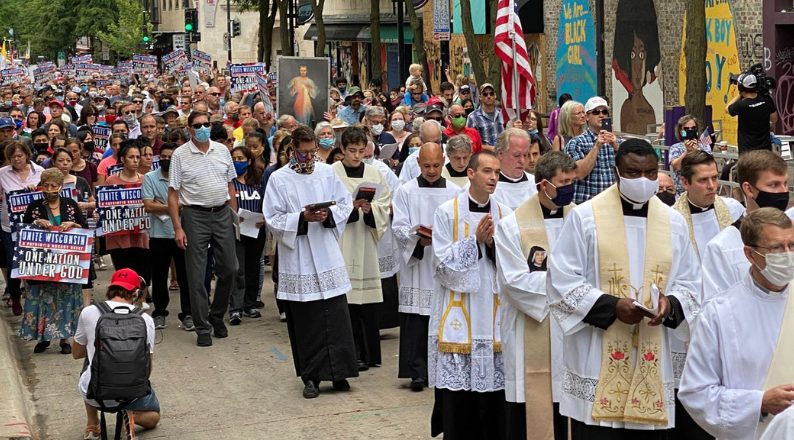Rafael Manuel Tovar
Four processions with the Most Blessed Sacrament will begin on May 19, 2024, and go across the United States to arrive together on June 16 in Indianapolis, where the National Eucharistic Congress will be held.
The four processions will form a gigantic cross over the United States map to Indianapolis. Perhaps the greatest Eucharistic pilgrimage in history will end on May 19 of the following year, Pentecost Sunday. They will start from four places in the country, which mark the cardinal points: the small glacial Lake Itasca, headwater of the Mississippi River in the north, New Haven, Connecticut in the east, Brownsville, Texas in the south and San Francisco, California, in the west.
Andrew Cozzens, Bishop of Crookston, Minnesota, President of the National Commission for Evangelization and Catechesis, described the project thus: “We want the greater part of the trajectory to be done walking, but, obviously, it will not always be possible. There are desert areas in which a vehicle will be used. We think there will be two types of processions. Those that we call major processions will be similar to those undertaken for the Solemnity of Corpus Christi. They will take place primarily on the outskirts of cities and the most numerous populations, if the parish priest or Bishop so wish. The Most Blessed Sacrament will be carried under a canopy, accompanied by a processional cross, candles and incense, while hymns are sung and prayers recited. Instead, there will be smaller processions for other thousands of kilometers.”
They will go across the country over two months. The initiative calls for a intense logistical effort, but it has great symbolic reach. There will be stretches with a simple procession, where a priest or deacon carries the Most Blessed Sacrament in a monstrance, but without a canopy, and with people pilgrimaging in a prayerful attitude, or in a vehicle. “Sometimes it will be used for bad weather, sometimes for security, sometimes to cover routes that would be difficult to do on foot,” explained Will Peterson, the project’s organizational manager.

The longest route will start from the west and follows the Serra Route – from Saint Junípero Serra, which covers 3,500 kilometers. And the shortest will be the Seton Route, named after the first native Saint of the United States, Elizabeth Ann Seton, which covers 1,500 kilometers. It is hoped that the routes will take the same time, for a coordinated arrival in Indianapolis. It is also hoped that some parishes and Catholic institutions will process a stretch and that there will be a stable nucleus of participants over two months. The Franciscan Friars od Renewal, Congregation founded in New York in 1987 by Father Benedict Groeschel, will offer the majority of priests for the route.
The routes will include stars and stripes flags in University campuses, villages and significant shrines of the history of American Catholicism. Tim Glemkowski, the Eucharist Congress’ Executive Director, pointed out that “it will be a way to meet people in prayer, giving witness of our faith. We have two key words to explain the Eucharistic Congress to those that ask us what it is: encounter and mission. An encounter with Jesus alive in the Eucharist, who sends us on mission as Church.”
Last year, the Fort Wayne-South Bend diocese marked the projection of this event when on June 4, 2022, after Mass in the Co-Cathedral of the Immaculate Conception, a numerous group of lay people, priests, Bishops and Religious left in procession with the Most Blessed Sacrament to the Co-Cathedral of Saint Mark in South Bend, a week later. More than 120 kilometers with Jesus in the Sacrament accompanying, visiting, blessing and pitying Him to take peace to all people, believers and non-believers.
Pew Research Center, famous institute of sociological research, published its finding that, among Catholics, 69% of those surveyed considered the bread and wine consecrated during Mass mere symbols of Christ’s presence and only 31% believed that they were really the Lord’s Body and Blood.
There has been no lack of detractors of this procession: the difficulty to count on thousands of volunteers, to coordinate routes, much help [needed] from governmental bodies such as police, town halls, medical and emergency services. But every difficulty is small given the purpose to bring people closer to the Eucharist. If He is present in every Tabernacle, if He gives Himself as food in every Eucharist, if He doesn’t cease to act and call for peace, joy, and the reconciliation of the whole world, why not accompany Him on roads, squares and towns of the United States?


